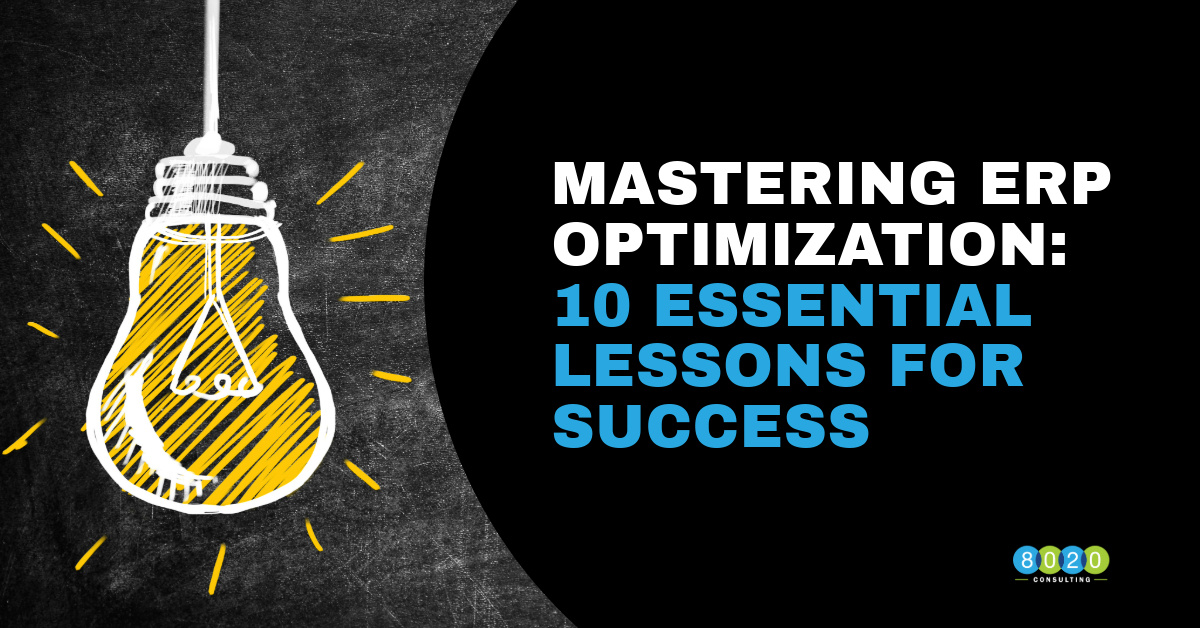Mastering ERP Optimization: 10 Essential Lessons for Success
- Updated on October 1, 2024
- Lora Mekikian
- Approx. Read Time: 3 minutes read
- Published on June 15, 2024


Enterprise Resource Planning (ERP) systems are the backbone of modern businesses, but implementing changes to these complex systems can be a daunting challenge. Having led numerous ERP transformations throughout my career, I’ve seen firsthand the pitfalls that can derail even the most well-intentioned projects. But fear not! In this blog, I’ll share 10 hard-won lessons I’ve learned from the trenches, covering everything from meticulous planning and effective communication to data management, vendor selection, and continuous improvement.
Whether you’re an ERP veteran or a newcomer to the field, this guide will equip you with the knowledge and strategies you need to navigate the complexities of ERP changes and achieve a successful implementation.
Before diving headfirst into an ERP transformation, take a deep breath and plan meticulously. This means thoroughly assessing your current situation, crystallizing your objectives, setting a realistic timeline, and allocating resources wisely. Rushing into an ERP change without a well-thought-out plan is a recipe for disaster, leading to costly mistakes and disruptions that could have been avoided.
Clear and consistent communication is the glue that holds an ERP implementation together. Explain the reasons behind the change, address concerns head-on, and keep stakeholders informed at every step. Transparency builds trust and encourages buy-in from employees at all levels, minimizing resistance and fostering collaboration.
ERP changes don’t just affect processes and technology; they impact people too. Invest in change management strategies to overcome resistance, create excitement, and ensure a smooth transition for everyone involved. Comprehensive training, ongoing support, and open channels for feedback can make all the difference in helping employees adapt to the new system.
Data integrity is the backbone of a successful ERP system. Implement robust data governance frameworks, rigorous data validation protocols, and regular audits to ensure the accuracy, completeness, and reliability of your information. Remember, garbage in, garbage out.
Data migration is a significant part of any ERP implementation, both in terms of effort and cost. During the planning phase, have candid discussions with stakeholders about the amount and type of data that needs to be migrated. Consider factors like historical data for trending analysis and reporting. Aim for a balance that meets the needs of the business without breaking the bank. I’ve found that migrating a year’s worth of detailed data and 2-3 years of summary data at a specific point in time (like month-end or quarter-end) is often a good compromise.
ERP changes touch many different parts of an organization, from finance and operations to human resources and supply chain management. To avoid creating silos, encourage collaboration between departments. Working together ensures everyone is aligned with the business objectives and helps to avoid potential conflicts. Collaboration also makes end-users feel involved, which leads to greater acceptance of the new system.
Even with the most meticulous planning, unexpected challenges will inevitably arise during your ERP implementation. Embrace flexibility and adaptability to navigate these unforeseen obstacles. Be willing to adjust timelines, reallocate resources, and make course corrections as needed. Remember, the ability to pivot is key to staying on track.
Despite careful planning, unexpected challenges and obstacles are bound to arise during ERP implementations. Maintaining flexibility and adaptability is key to navigating unforeseen circumstances. Being open to course corrections, adjusting timelines as needed, and reallocating resources based on evolving priorities can help mitigate risks and keep the project on track. Incorporating “unplanned project obstacles” into the initial timeline can provide the necessary buffer to address these issues.
View your ERP implementation as a journey, not a destination. After go-live, foster a culture of continuous improvement to maximize the long-term value of your system. Encourage feedback from users, identify areas for optimization, and embrace new functionalities as they become available. Also, share your feedback with the vendor so they can incorporate customer concerns into future updates.
In the midst of the ERP whirlwind, it’s easy to get caught up in the details and lose sight of the bigger picture. Keep your eyes on the prize: your desired business outcomes. Whether it’s improving efficiency, enhancing decision-making, or driving growth, make sure every aspect of your ERP implementation is aligned with these goals.
By following these lessons, you can navigate the complexities of ERP changes with confidence and achieve the transformative results you envision for your organization.
Organizations increasingly use audit management systems (AMS) to ...
Read MoreAuditing plays a vital role in ensuring compliance, managing risk, ...
Read MoreManaging compliance and security is increasingly complex, especially ...
Read More